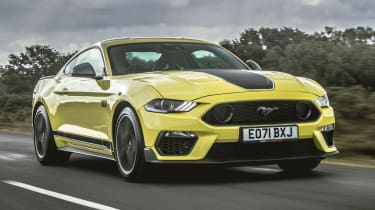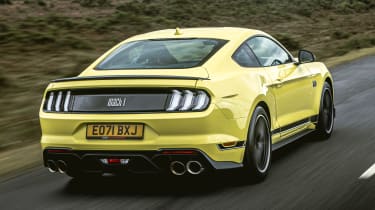Ford Mustang coupe review (2015-2024)
“The Ford Mustang combines old-fashioned charm with modern performance and is fantastic value”
Pros
- Fantastic fun to drive
- Huge performance
- Great value
Cons
- Lacks sophistication
- Ride slightly too firm
- Suspect interior quality
The Ford Mustang is the world’s most iconic and popular muscle car, but had never been officially sold in the UK until the sixth generation arrived in 2015 – there's now a new model which you can read about here. The Mustang has come a long way from the original version, too – it can handle corners as well as power down straights.
A big change is that the Mustang name is no longer reserved solely for the brawny V8 coupe and convertible; the Ford Mustang Mach-E wears the famous badge but is an electric five-door SUV. That upset some enthusiasts but it shows the lengths that Ford will go to when making its first purpose-built electric car appealing. The car itself shows that electric cars can be fun and fast.
Ford hasn’t forgotten the most important selling point of the coupe, which has always been huge performance for not a lot of cash. The Mustang GT, with a 5.0-litre V8 and 444bhp, starts from around £50,000, some £6,000 less than a 2.5-litre Audi TT RS or 3.0-litre Toyota Supra.
For similar money to its rivals, there’s the Mach 1 model of the Ford Mustang. Not to be confused with the Mach-E, the Mach 1 is a tweaked version of the petrol-powered Mustang, with improvements to the suspension, engine and aerodynamics. It’s the hottest Mustang sold in Europe and has greater ability on a racetrack and through fast corners.
Ford previously sold a slightly more affordable Mustang with a 2.3-litre engine that’s related to the one in the Ford Focus ST. It didn’t appeal to many of the car’s fans because it didn’t have the spine-tingling V8 soundtrack or image. It wasn’t actually significantly more economical than the V8 either.
More reviews
In-depth reviews
Road tests
If you’re considering one of the Mustang’s German rivals for a similar amount of money, you’ll be looking at a relatively low-spec Audi A5 or BMW 4 Series, with less power and road presence, but with better cabin quality. Some of the materials inside the Mustang don’t look as good as you’d hope, but they’ve been improved somewhat in the facelifted car (post-2018), and at least its SYNC 3 infotainment system is very good and includes Apple CarPlay and Android Auto.
The car might be cheap to buy but running costs are likely to be higher than those of some rivals. The V8 has high emissions, and while the discontinued 2.3-litre EcoBoost performed better in this regard, fuel consumption was still high. When it was available, the smaller 2.3-litre engine was the economy champion of the Mustang range returning around 31mpg with a manual gearbox. The thirstier 5.0-litre manages around 24mpg with its standard 10-speed automatic gearbox, falling to around 23mpg in the discontinued manual model.
Despite the running costs, it's always been easy to pick out the V8 as the best Mustang. You might have to spend a lot on fuel, but if you want the authentic Mustang driving experience, it’s the only option. While the old 2.3-litre wasn’t a bad engine per se, the rumble of the V8 and its sweeping power delivery provide the authentic Mustang driving experience.
While it’s an option in the USA, all right-hand-drive cars get Ford’s Performance Pack as standard, with enhanced brakes and firmer suspension. The Mustang certainly feels planted, resisting body lean in tight corners, but the ride is also firmer than many competitors. Still, even taking its size and weight into account, the Ford is serious fun. Choosing the optional MagneRide adaptive suspension (standard on the Mach 1) makes it even better, rounding off bumps for an even more sophisticated feel.
Look in the Mustang’s boot and it’s easy to convince yourself it’s a practical car, with room for two large suitcases, but the rear seats are cramped, with poor knee room making them virtually off-limits for adults.

















